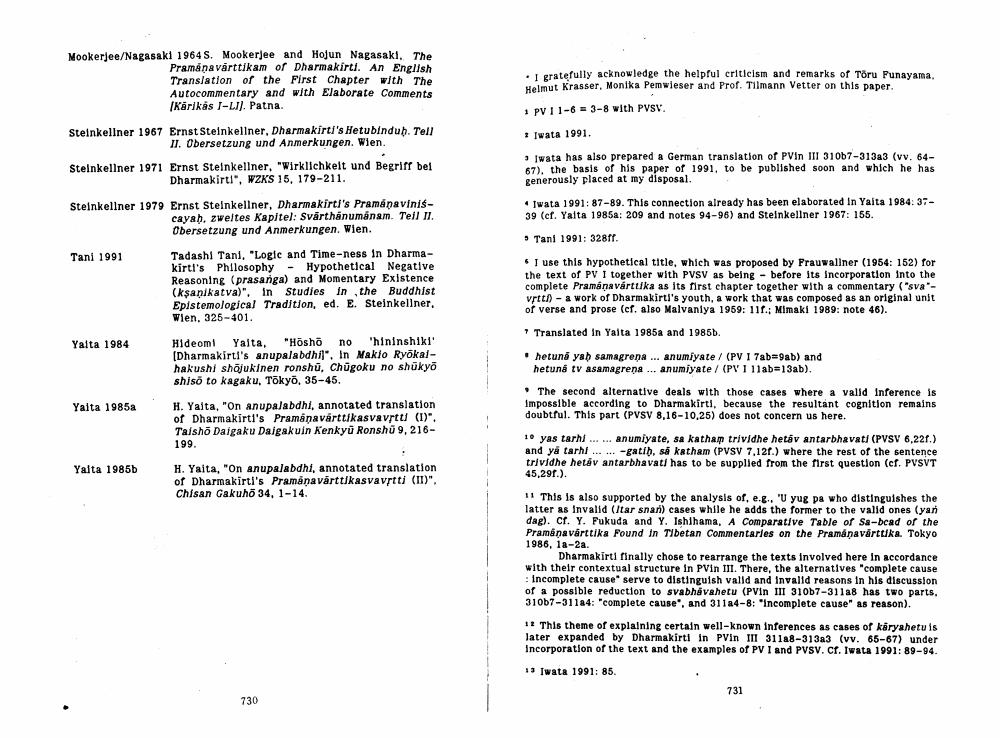________________
Mookerjee/Nagasaki 1964 S. Mookerjee and Hojun Nagasaki. The Pramanavarttikam of Dharmakirti. An English Translation of the First Chapter with The Autocommentary and with Elaborate Comments [Karikas I-LI). Patna.
Steinkellner 1967 Ernst Steinkellner, Dharmakirti's Hetubindub. Tell II. Übersetzung und Anmerkungen. Wien. Steinkellner 1971 Ernst Steinkellner, "Wirklichkeit und Begriff bei Dharmakirt!", WZKS 15, 179-211.
Steinkellner 1979 Ernst Steinkellner, Dharmakirti's Pramanaviniscayah, zweltes Kapitel: Svarthanumanam. Teil II. Übersetzung und Anmerkungen. Wien.
Tani 1991
Yalta 1984
Yalta 1985a
Yalta 1985b
-
Tadashi Tani, "Logic and Time-ness in Dharmakirti's Philosophy Hypothetical Negative. Reasoning (prasanga) and Momentary Existence (kṣaṇikatva)", in Studies in the Buddhist Epistemological Tradition, ed. E. Steinkellner, Wien, 325-401.
Hideomi Yalta, "Hōshō no 'hininshiki' [Dharmakirti's anupalabdhi". In Makio Ryōkalhakushi shōjukinen ronshu, Chugoku no shūkyō shiso to kagaku, Tokyo, 35-45.
H. Yalta, "On anupalabdhi, annotated translation of Dharmakirti's Pramanavärttikasvavṛtti (1)", Taishō Daigaku Daigakuin Kenkyu Ronshu 9, 216
199.
H. Yaita, "On anupalabdhi, annotated translation of Dharmakirti's Pramanavarttikasvavṛtti (II)". Chisan Gakuho 34, 1-14.
730
I gratefully acknowledge the helpful criticism and remarks of Töru Funayama, Helmut Krasser, Monika Pemwieser and Prof. Tilmann Vetter on this paper.
1 PV 11-63-8 with PVSV.
Iwata 1991.
Iwata has also prepared a German translation of PVin III 310b7-313a3 (vv. 6467), the basis of his paper of 1991, to be published soon and which he has generously placed at my disposal.
Iwata 1991: 87-89. This connection already has been elaborated in Yaita 1984: 3739 (cf. Yalta 1985a: 209 and notes 94-96) and Steinkellner 1967: 155.
Tani 1991: 328ff.
I use this hypothetical title, which was proposed by Frauwallner (1954: 152) for the text of PV I together with PVSV as being before its incorporation into the complete Pramanavarttika as its first chapter together with a commentary ("sva"vrtti) a work of Dharmakirti's youth, a work that was composed as an original unit of verse and prose (cf. also Malvaniya 1959: 11f.; Mimaki 1989: note 46). Translated in Yalta 1985a and 1985b.
⚫hetuna yaḥ samagrena... anumiyate/ (PV I 7ab=9ab) and hetuna tv asamagrena... anumiyate / (PV I 11ab=13ab).
The second alternative deals with those cases where a valid inference is Impossible according to Dharmakirti, because the resultant cognition remains doubtful. This part (PVSV 8,16-10,25) does not concern us here.
10 yas tarhi...... anumiyate, sa katham trividhe hetav antarbhavati (PVSV 6,221.) and ya tarhi ...-gatib, sa katham (PVSV 7,12f.) where the rest of the sentence trividhe hetev antarbhavati has to be supplied from the first question (cf. PVSVT 45,291.).
11 This is also supported by the analysis of, e.g.. 'U yug pa who distinguishes the latter as invalid (Itar snar) cases while he adds the former to the valid ones (yan dag). Cf. Y. Fukuda and Y. Ishihama, A Comparative Table of Sa-bead of the Pramanavarttika Found in Tibetan Commentaries on the Pramanavarttika. Tokyo 1986, la-2a.
Dharmakirti finally chose to rearrange the texts involved here in accordance with their contextual structure in PVin III. There, the alternatives "complete cause : incomplete cause" serve to distinguish valid and invalid reasons in his discussion of a possible reduction to svabhavahetu (PVin III 310b7-311a8 has two parts. 310b7-311a4: "complete cause", and 311a4-8: "incomplete cause" as reason).
12 This theme of explaining certain well-known inferences as cases of karyahetu is later expanded by Dharmakirti in PVin III 311a8-313a3 (vv. 65-67) under Incorporation of the text and the examples of PV I and PVSV. Cf. Iwata 1991: 89-94.
13 Iwata 1991: 85.
731




